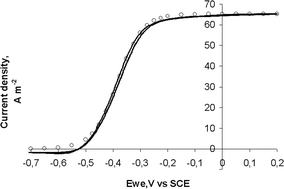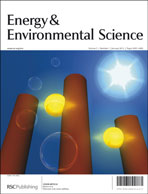Electroactive biofilms were formed from garden compost leachate on platinum wires under constant polarisation at −0.2 V vs.SCE and temperature controlled at 40 °C. The oxidation of 10 mM acetate gave maximum current density of 7 A m−2 with the electrodes of largest diameters (500 and 1000 μm). The smaller diameter wires exhibited an ultra-microelectrode (UME) effect, which increased the maximum current density up to 66 A m−2 with the 25 μm diameter electrode. SEM imaging showed biofilms around 75 μm thick on the 50 μm diameter wire, while they were only 25 μm thick on the 500 μm diameter electrode. Low scan cyclic voltammetry (CV) curves were similar to those already reported for biofilms formed with pure cultures of G. sulfurreducens. Concentrations of the redox molecules contained in the biofilms, which were derived from the non-turnover CVs, were around 0.4 to 0.6 mM, which was close to the value of 1 mM extracted from literature data for G. sulfurreducens biofilms. A numerical model was designed, which demonstrated that the microbial anodes were not controlled here by microbial kinetics. Introducing the concept of average electron transport length made the model well fitted with the experimental results, which indicates rate control by electron transport through the biofilm matrix. According to this model, the UME effect improved the electron transport network in the biofilm, which allowed the biofilm to grow to greater thickness.

You have access to this article
 Please wait while we load your content...
Something went wrong. Try again?
Please wait while we load your content...
Something went wrong. Try again?


 Please wait while we load your content...
Please wait while we load your content...